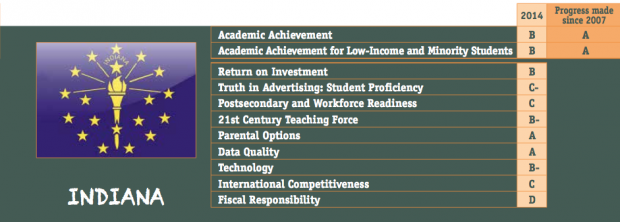State Receives Mostly B’s In U.S. Chamber Of Commerce Report Card

ludwg (flickr)
The "Leaders and Laggards" report is written by the U.S. Chamber of Commerce Foundation.
Indiana earned top grades in school choice and data quality in its education system, according to the U.S. Chamber of Commerce Foundation’s 2014 “Leaders and Laggards: A State-by-State Report Card on K-12 Educational Effectiveness” report released Thursday.
The report looks at the state of education and its effectiveness on students, communities and the country as a whole. Each state was given an A-F grade for 11 areas of a state’s education system, including academic achievement, postsecondary and workforce readiness, parental options and fiscal responsibility to name a few. (All of the grades are listed below and descriptions of each category and how the grades were calculated are outlined here.)
One of the A’s on Indiana’s report card was for parental options, because “Indiana does an excellent job providing parents with strong school choice options…and one of the most expansive statewide school choice programs in the country.” Another A was data quality, with the report praising the state’s “excellent grade collection and reporting high-quality education data.”

leadersandlaggards.org
Indiana earned mostly B's in the 11 areas of educational improvement included in the U.S. Chamber of Commerce Foundation's report card released today.
Areas where Indiana was graded poorly were in the areas of postsecondary and workforce readiness, truth in advertising and fiscal responsibility.
Indiana earned a C in postsecondary and workforce readiness because of low passing rates on AP exams and because 20 percent of high school students do not graduate in four years. The state was also rated 23rd for percentage of students passing STEM-related AP tests, which was a large focus of the report.
The D for fiscal responsibility comes from the fact that only 61 percent of the Indiana Public Retirement System (public employee pension) is funded.
Andrew Ujifusa of Education Week writes about details to keep in mind when reading the report:
A caveat is that some will find ideological or other reasons to be critical of the organizations and indicators used by the Chamber. The group relies on a variety of assessments and K-12 policy organizations for its rankings, including the National Council on Teacher Quality and Education Next magazine. Some have questioned NCTQ’s research practices, for example, and Education Next publishes articles supporting school choice. The Chamber also praises the states for adopting “higher standards,” a reference to the Common Core State Standards.
Other things to keep in mind: Every category was graded on a curve with 10 states consistently receiving each letter grade.
Also, many of the areas that used student scores to calculate the letter grade used National Assessment of Educational Progress (NAEP) scores, which are only given to a sampling of fourth, eighth and twelfth graders in the state each year.